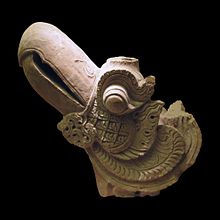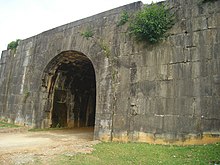| Revision as of 16:17, 11 June 2013 editEdJohnston (talk | contribs)Autopatrolled, Checkusers, Administrators71,240 editsm EdJohnston moved page Ho dynasty to Hồ Dynasty: Per move discussion at Talk:Sông Công← Previous edit | Revision as of 16:20, 11 June 2013 edit undoEdJohnston (talk | contribs)Autopatrolled, Checkusers, Administrators71,240 editsm Protected Hồ Dynasty: Move warring: Numerous moves in 2013, usually with no discussion ( (expires 16:20, 11 June 2014 (UTC)))Next edit → |
| (No difference) | |
Revision as of 16:20, 11 June 2013
| Hồ dynasty | |
|---|---|
| Vietnamese name | |
| Vietnamese alphabet | Nhà Hồ |
| Hán-Nôm | 胡朝 |
The Hồ dynasty was a short-lived seven-year reign of two emperors, Hồ Quý Ly in 1400 and his second son, Hồ Hán Thương, who reigned from 1400 to 1407. The practice of bequeathing the throne to a designated son (not simply passing it on to the eldest) was similar to what had happened in the previous Trần Dynasty and was meant to avoid sibling rivalry. Hồ Quý Ly's eldest son, Hồ Nguyên Trừng, played his part as the dynasty's military general. In 2011, UNESCO declared the Ho Dynasty Citadel in Thanh Hoa Province a world heritage site.
Hồ Quý Ly (c. 1350 – c. 1410)
Origin and background
The appearance of the Hồ family name, origin and background can be traced back to 9th century Zhejiang, which was then in the midst of the Five Dynasties struggle. From Zhejiang, the family migrated south until they established themselves in Nam Viet (Vietnam). Hồ Liêm, Hồ Quý Ly's great-great-grandfather, moved further south and settled in the province of Thanh Hóa (about 100 km south of the modern city of Hanoi). Some historians bring attention to the fact that Hồ Quý Ly (胡 季 犛) is also known as Lê Quý Ly (黎 季 犛). In his childhood, Hồ Quý Ly was adopted by Lê Huan after whom he took the family name. He did not change this Lê last name to Hồ until after he had deposed the last king of the Trần. Because of the short span of the Hồ dynasty and the tragic circumstances he brought upon the country, under the juggle of the Ming, the family name "Hồ" was disgraced thereafter. However, historians have attributed to Hồ family quite a few notable scholars, dignitaries, and government officials under both the Lý dynasty and Trần dynasty.
Hồ Quý Ly's ascent to power
First of all, one has to say that the Trần dynasty's authority and power in the 1370s and 1380s declined steadily after Trần Nghệ Tông's reign (1370–1372). He had ceded the throne in favor of his son Trần Duệ Tông (1372–1377), his grandson Trần Phế Đế (1377–1388), and Trần Thuận Tông (1388–1398) one of his younger sons.
The Trần dynasty became known for emperors who reigned for only a few years before relinquishing the throne to a favorite son, and becoming Thái Thượng Hoàng Đế, the first dynasty to take the name of Father of "Hoàng Đế" emperor title. These types of short-lived and short-sighted emperors encouraged the arrival and ascension of strong, skillful and sly politicians. Hồ Quý Ly was such a politician. He was widely known for his cunning, courage, and boldness, and had distinguished himself in a successful campaign against the Chams of Champa. Through his scheming and shrewd marriage alliances (to a sister of Emperor Trần Duệ Tông and Trần Thuận Tông), Hồ Quý Ly made himself a court fixture in the position of the emperors' indispensable advisor. In less than 20 years, while many others involved in court intrigues were being assassinated all around him, Hồ Quý Ly attained the highest post of General/Protector/Regent of the country in 1399.
Coup d'etat of Hồ Quý Ly (1399)

To facilitate his takeover, Hồ Quý Ly first had a new capital built, called Tây Đô (literally "Western Capital"). In 1399, he invited the current emperor, Trần Thuận Tông, to visit this new capital. After coaxing the emperor into relinquishing the throne to Prince An (a three-year-old child) he had Trần Thuận Tông imprisoned in a pagoda and later executed. Prince An "reigned" for one year until Hồ Quý Ly deposed him in 1400 and declared himself to be the new emperor.
Hồ Quý Ly immediately changed the country's name from Đại Việt to Đại Ngu (大 虞). Taking a page from the ruling book of his Trần predecessors, Hồ Quý Ly reigned less than a year before relinquishing the throne to his second son, Hồ Hán Thương. He then became known as the Emperor's Highest Father.
Final years
In 1402 the army of the Hồ dynasty under general Đỗ Mãn made significant inroads against Champa, prompting the Champa king to cede large territory to Vietnam. However after the defeat of the Hồ Dynasty by the Ming in 1407, Hồ Quý Ly, his sons Hồ Hán Thương and Hồ Nguyên Trưng, and other relatives were captured and sent to Guangxi. There Hồ Quý Ly was put to work as a Chinese soldier and security guard until the end of his life.


Hồ Hán Thương, emperor 1400–1407
Diplomacy with the Ming
Stable relations with the Ming dynasty were Hồ Quý Ly's foremost concern. Unfortunately, this matter proved impossible for the Hồ to pursue by that time of civil unrest. The descendants of the deposed Trần dynasty had begun agitating against the "usurper" Hồ Quý Ly. This internal disquiet kept the country in chaos and allowed an opportunity for the Ming to conquer Dai Viet with the help of the Trần sympathizers. From 1400 through 1405, the Hồ tried in vain to regain China's goodwill. They sent emissaries and diplomats with offerings to Beijing but the gifts were each time refused or belittled. Hồ Quý Ly (though not an emperor at that time) realized that this stubborn attitude indicated that sooner or later the Ming would invade his country and obligate him to defend it.
War with the Ming and the 4th Chinese domination
Further information: Ming–Hồ War and Fourth Chinese domination of VietnamThis war began in 1406 when the Yongle Emperor sent Marquis Zhang Fu and Marquis Mu Sheng with two forces to lead an invasion. In 1407, the fall of Da Bang fortress, and the defeats of the Hồ at Moc Pham Giang and Ham Tu all precipitated the fall of the Hồ dynasty. At the Ham Tu battle, the Hồ family tried to escape the enemy but was caught by the Ming and sent to exile in China. From 1407 till 1417, the Ming ruled Nanyue more ruthlessly than ever before. It is said the Ming sent valuable treasures such as gems, jade, and golden artworks, as well as many valuable books, back to Beijing. Among these were the National History Books of Vietnam which told of Vietnam's past up to the Trần Dynasty. The cruelty and exploitation of the Ming fueled the awakening of the Việt Rebellion led by Lê Lợi.
Economy and finance
Although the leader of the most unpopular and probably the most hated dynasty in the history of Vietnam, Hồ Quý Ly nevertheless initiated many economic, financial and educational reforms. One notable reform for which Hồ is credited was the introduction of the a country-wide paper currency around 1399 or 1400. Other reforms included land reform, opening of ports to foreign trade, reform of the judiciary, health care and opening the education system to study mathematics and agriculture alongside Confucian texts.
See also
References
- "Ho Dynasty Citadel becomes world heritage site", Tuoi Tre News, June 28, 2011
- Andrew David Hardy, Mauro Cucarzi, Patrizia Zolese Champa and the Archaeology of Mỹ Sơn (Vietnam) 2009 Page 68 "In 1402, the Hồ dynasty sent General Đỗ Mãn to lead the army against Champa."
- Anh Tuấn Hoàng Silk for Silver: Dutch-Vietnamese Relations, 1637-1700 2007 -- Page 133 "There was a brief period during the Hồ Dynasty (1400−7) when paper money was introduced."
- Jan Dodd, Mark Lewis, Ron Emmons The Rough Guide to Vietnam 4th Edition 2003- Page 486 "Though the Ho dynasty lasted only seven years, its two progressive monarchs launched a number of important reforms. They tackled the problem of land shortages by restricting the size of holdings and then rented out the excess to landless peasants, the tax system was revised and paper money replaced coinage, ports were opened to foreign trade, the judiciary was overhauled and public health care introduced. Even the education system came under review and was broadened to include mathematics, agriculture and other practical subjects along with the classic Confucian texts."
- Viet Nam Toan Thu, by Pham Van Son
- Viet Nam Su Luoc, by Trần Trọng Kim
